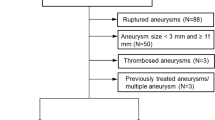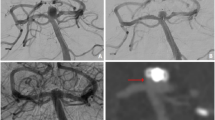Abstract
Purpose
Endovascular coil occlusion represents the standard treatment for basilar tip aneurysms. Recently, this role has been rivalled by intrasaccular flow disruptors across numerous centres. We retrospectively compared WEB embolization and coiling for the treatment of ruptured basilar tip aneurysms.
Methods
Patients treated with WEB or coiling at four neurovascular centres were reviewed. Procedure-related complications, clinical outcome, and angiographic results were retrospectively compared.
Results
The study included 23 patients treated with the WEB (aneurysm size: 6.6 ± 1.9 mm) and 56 by coiling (aneurysm size: 6.7 ± 2.5 mm). Stent-assistance was more often necessary with coiling than with WEB embolization (32% vs. 4%, p = 0.009). A modified Rankin scale score ≤ 2 at discharge had 21 (37.5%) patients in the coiling group and 12 (52.2%) in the WEB group (p = 0.235). Immediate complete and adequate occlusion rates were 52% for the WEB and 87% for coiling. At short-term follow-up, these rates were 87% for the WEB and 72% for coiling, respectively. There was no delayed aneurysm re-bleeding during follow-up.
Conclusion
Both coiling and WEB seem to prevent rebleeding in ruptured BTA aneurysms. WEB embolization required less frequently stent-support than coiling, potentially advantageous for SAH patients to avoid anti-platelet therapy in the light of concomitant procedures like ventricular drainage.



Similar content being viewed by others
Data availability
The datasets generated during and/or analysed during the current study are available from the corresponding author on reasonable request.
References
Brisman JL, Song JK, Newell DW (2006) Cerebral aneurysms. N Engl J Med 355:928–939
Caranci F, Briganti F, Cirillo L, Leonardi M, Muto M (2013) Epidemiology and genetics of intracranial aneurysms. Eur J Radiol 82:1598–1605
Hong Q, Li W, Ma J, Jiang P, Zhang Y (2021) Endovascular treatment of vertebral and basilar artery aneurysms with low-profile visualized intraluminal support device. BMC Neurol 21:198
Eskridge JM, Song JK (1998) Endovascular embolization of 150 basilar tip aneurysms with Guglielmi detachable coils: results of the Food and Drug Administration multicenter clinical trial. J Neurosurg 89:81–86
Schievink WI, Wijdicks EF, Piepgras DG, Chu CP, O’Fallon WM et al (1995) The poor prognosis of ruptured intracranial aneurysms of the posterior circulation. J Neurosurg 82:791–795
Chalouhi N, Jabbour P, Gonzalez LF, Dumont AS, Rosenwasser R et al (2012) Safety and efficacy of endovascular treatment of basilar tip aneurysms by coiling with and without stent assistance: a review of 235 cases. Neurosurg 71:785–794
Lusseveld E, Brilstra E, Nijssen P, van Rooij W, Sluzewski M et al (2002) Endovascular coiling versus neurosurgical clipping in patients with a ruptured basilar tip aneurysm. J Neurol Neurosurg Psychiatry 73:591–593
Maus V, Mpotsaris A, Dorn F, Möhlenbruch M, Borggrefe J et al (2018) The use of flow diverter in ruptured, dissecting intracranial aneurysms of the posterior circulation. World Neurosurg 111:e424–e433
Pierot L, Spelle L, Vitry F (2008) Immediate clinical outcome of patients harboring unruptured intracranial aneurysms treated by endovascular approach: results of the ATENA study. Stroke 39:2497–2504
Liebig T, Kabbasch C, Strasilla C, Berlis A, Weber W et al (2015) Intrasaccular flow disruption in acutely ruptured aneurysms: a multicenter retrospective review of the use of the WEB. Am J Neuroradiol 36:1721–1727
Pierot L, Moret J, Barreau X, Szikora I, Herbreteau D et al (2018) Safety and efficacy of aneurysm treatment with WEB in the cumulative population of three prospective, multicenter series. J Neurointerv Surg 10:553–559
Papagiannaki C, Spelle L, Januel A-C, Benaissa A, Gauvrit J-Y et al (2014) WEB intrasaccular flow disruptor—prospective, multicenter experience in 83 patients with 85 aneurysms. Am J Neuroradiol 35:2106–2111
Pierot L, Biondi A (2016) Endovascular techniques for the management of wide-neck intracranial bifurcation aneurysms: a critical review of the literature. J Neuroradiol 43:167–175
Pierot L, Klisch J, Cognard C, Szikora I, Mine B et al (2013) Endovascular WEB flow disruption in middle cerebral artery aneurysms: preliminary feasibility, clinical, and anatomical results in a multicenter study. Neurosurg 73:27–35
Kabbasch C, Goertz L, Siebert E, Herzberg M, Borggrefe J et al (2019) Comparison of WEB embolization and coiling in unruptured intracranial aneurysms: safety and efficacy based on a propensity score analysis. World Neurosurg 126:e937–e943
Dmytriw AA, Diestro JDB, Dibas M, Phan K, Sweid A et al (2022) International study of intracranial aneurysm treatment using Woven EndoBridge: results of the WorldWideWEB Consortium. Stroke 53:e47–e49
Al Saiegh F, Hasan D, Mouchtouris N, Zanaty M, Sweid A et al (2020) Treatment of acutely ruptured cerebral aneurysms with the Woven EndoBridge device: experience post-FDA approval. Neurosurg 87:E16–E22
Henkes H, Fischer S, Mariushi W, Weber W, Liebig T et al (2005) Angiographic and clinical results in 316 coil-treated basilar artery bifurcation aneurysms. J Neurosurg 103:990–999
Peluso JP, van Rooij WJ, Sluzewski M, Beute GN (2008) Coiling of basilar tip aneurysms: results in 154 consecutive patients with emphasis on recurrent haemorrhage and re-treatment during mid- and long-term follow-up. J Neurol Neurosurg Psychiatry 79:706–711
Piotin M, Blanc R, Spelle L, Mounayer C, Piantino R et al (2010) Stent-assisted coiling of intracranial aneurysms: clinical and angiographic results in 216 consecutive aneurysms. Stroke 41:110–115
Bartolini B, Blanc R, Pistocchi S, Redjem H, Piotin M (2014) “Y” and “X” stent-assisted coiling of complex and wide-neck intracranial bifurcation aneurysms. AJNR Am J Neuroradiol 35:2153–2158
Goertz L, Smyk MA, Siebert E, Turowski B, Borggrefe J et al (2021) Low-profile laser-cut stents for endovascular treatment of intracranial aneurysms. Clin Neuroradiol 31:107–115
Goertz L, Liebig T, Siebert E, Pflaeging M, Forbrig R et al (2022) Stent-assisted WEB embolization: aneurysm characteristics, outcome and case report of a WEB delivered through a stent. Acta Neurochirurgica 164(2):2181–2190
Marcolini E, Hine J (2019) Approach to the diagnosis and management of subarachnoid hemorrhage. West J Emerg Med 20:203–211
Behme D, Berlis A, Weber W (2015) Woven EndoBridge intrasaccular flow disrupter for the treatment of ruptured and unruptured wide-neck cerebral aneurysms: report of 55 cases. Am J Neuroradiol 36:1501–1506
Popielski J, Berlis A, Weber W, Fischer S (2018) Two-center experience in the endovascular treatment of ruptured and unruptured intracranial aneurysms using the WEB device: a retrospective analysis. AJNR Am J Neuroradiol 39:111–117
Youssef PP, Dornbos D III, Peterson J, Sweid A, Zakeri A et al (2021) Woven EndoBridge (WEB) device in the treatment of ruptured aneurysms. J NeuroInterventional Surg 13:443–446
Herbreteau D, Bibi R, Narata AP, Janot K, Papagiannaki C et al (2016) Are anatomic results influenced by WEB shape modification? Analysis in a prospective, single-center series of 39 patients with aneurysms treated with the WEB. AJNR Am J Neuroradiol 37:2280–2286
Pierot L, Szikora I, Barreau X, Holtmannspoetter M, Spelle L et al (2021) Aneurysm treatment with WEB in the cumulative population of two prospective, multicenter series: 3-year follow-up. J NeuroInterventional Surg 13:363–368
Sprengers ME, Schaafsma J, van Rooij WJ, Sluzewski M, Rinkel GJE et al (2008) Stability of intracranial aneurysms adequately occluded 6 months after coiling: a 3T MR angiography multicenter long-term follow-up study. Am J Neuroradiol 29:1768–1774
Ferns SP, Sprengers ME, van Rooij WJ, van Zwam WH, de Kort GA et al (2011) Late reopening of adequately coiled intracranial aneurysms: frequency and risk factors in 400 patients with 440 aneurysms. Stroke 42:1331–1337
Abecassis IJ, Sen RD, Barber J, Shetty R, Kelly CM et al (2019) Predictors of recurrence, progression, and retreatment in basilar tip aneurysms: a location-controlled analysis. Oper Neurosurg (Hagerstown) 16:435–444
Raymond J, Guilbert F, Weill A, Georganos SA, Juravsky L et al (2003) Long-term angiographic recurrences after selective endovascular treatment of aneurysms with detachable coils. Stroke 34:1398–1403
Kang HS, Han MH, Kwon BJ, Kwon OK, Kim SH (2006) Repeat endovascular treatment in post-embolization recurrent intracranial aneurysms. Neurosurg 58(1):60–70
Henkes H, Fischer S, Liebig T, Weber W, Reinartz J et al (2006) Repeated endovascular coil occlusion in 350 of 2759 intracranial aneurysms: safety and effectiveness aspects. Neurosurg 58(2):224–232
Gallas S, Januel AC, Pasco A, Drouineau J, Gabrillargues J et al (2009) Long-term follow-up of 1036 cerebral aneurysms treated by bare coils: a multicentric cohort treated between 1998 and 2003. AJNR Am J Neuroradiol 30:1986–1992
Chalouhi N, Jabbour P, Singhal S, Drueding R, Starke RM et al (2013) Stent-assisted coiling of intracranial aneurysms. Stroke 44:1348–1353
Geyik S, Yavuz K, Yurttutan N, Saatci I, Cekirge HS (2013) Stent-assisted coiling in endovascular treatment of 500 consecutive cerebral aneurysms with long-term follow-up. Am J Neuroradiol 34:2157–2162
Akhunbay-Fudge CY, Deniz K, Tyagi AK, Patankar T (2020) Endovascular treatment of wide-necked intracranial aneurysms using the novel contour neurovascular system: a single-center safety and feasibility study. J NeuroInterventional Surg 12:987–992
Vergouwen MD, Vermeulen M, van Gijn J, Rinkel GJ, Wijdicks EF et al (2010) Definition of delayed cerebral ischemia after aneurysmal subarachnoid hemorrhage as an outcome event in clinical trials and observational studies: proposal of a multidisciplinary research group. Stroke 41:2391–2395
Zhang S-M, Liu L-X, Ren P-W, Xie X-D, Miao J (2020) Effectiveness, safety and risk factors of woven EndoBridge device in the treatment of wide-neck intracranial aneurysms: systematic review and meta-analysis. World Neurosurg 136:e1–e23
Hetts S, Turk A, English J, Dowd C, Mocco J et al (2014) Stent-assisted coiling versus coiling alone in unruptured intracranial aneurysms in the matrix and platinum science trial: safety, efficacy, and mid-term outcomes. Am J Neuroradiol 35:698–705
Kabbasch C, Goertz L, Siebert E, Herzberg M, Borggrefe J et al (2019) WEB embolization versus stent-assisted coiling: comparison of complication rates and angiographic outcomes. J Neurointerv Surg 11(8):812–816
Pierot L, Szikora I, Barreau X, Holtmannspoetter M, Spelle L et al (2020) Aneurysm treatment with WEB in the cumulative population of two prospective, multicenter series: 3-year follow-up. J NeuroInterventional Surge 13(4):363–368
Fujimoto M, Lylyk I, Bleise C, Albiña P, Chudyk J et al (2020) Long-term outcomes of the WEB device for treatment of wide-neck bifurcation aneurysms. Am J Neuroradiol 41:1031–1036
Author information
Authors and Affiliations
Corresponding author
Ethics declarations
Competing interests
CK serves as consultant for Acandis GmbH (Pforzheim, Germany) and as proctor for MicroVention Inc./Sequent Medical (Aliso Viejo, CA, USA). TL serves as proctor for MicroVention Inc./Sequent Medical (Aliso Viejo, CA, USA), CERUS Endovascular (Fremont, CA, USA), Phenox, Stryker, and Medtronic. The other authors declare no competing interests.
Ethics approval
The study protocol was approved by the local ethics committee of the University Hospital of Cologne. The need for informed consent was waived by the local ethics committee of the University Hospital of Cologne. The study was conducted in accordance with the STROBE guidelines in compliance with the national legislation and the Code of Ethical Principles for Medical Research Involving Human Subjects of the World Medical Association (Declaration of Helsinki).
Additional information
Publisher's note
Springer Nature remains neutral with regard to jurisdictional claims in published maps and institutional affiliations.
Rights and permissions
Springer Nature or its licensor (e.g. a society or other partner) holds exclusive rights to this article under a publishing agreement with the author(s) or other rightsholder(s); author self-archiving of the accepted manuscript version of this article is solely governed by the terms of such publishing agreement and applicable law.
About this article
Cite this article
Celik, E., Goertz, L., Ozpeynirci, Y. et al. Comparative assessment of woven endobridge embolization and standard coil occlusion for the treatment of ruptured basilar tip aneurysms. Neuroradiology 65, 765–773 (2023). https://doi.org/10.1007/s00234-022-03096-4
Received:
Accepted:
Published:
Issue Date:
DOI: https://doi.org/10.1007/s00234-022-03096-4




